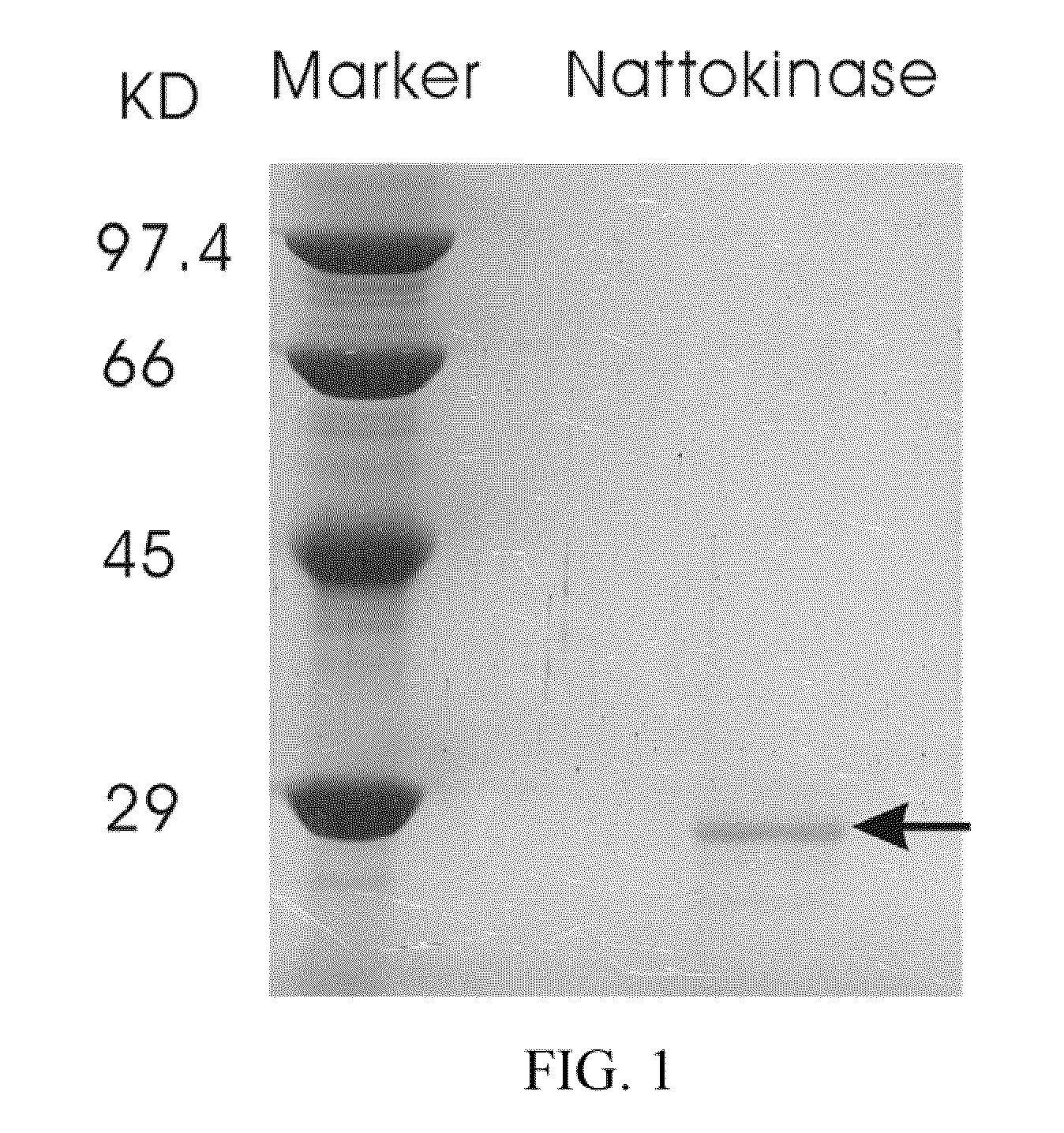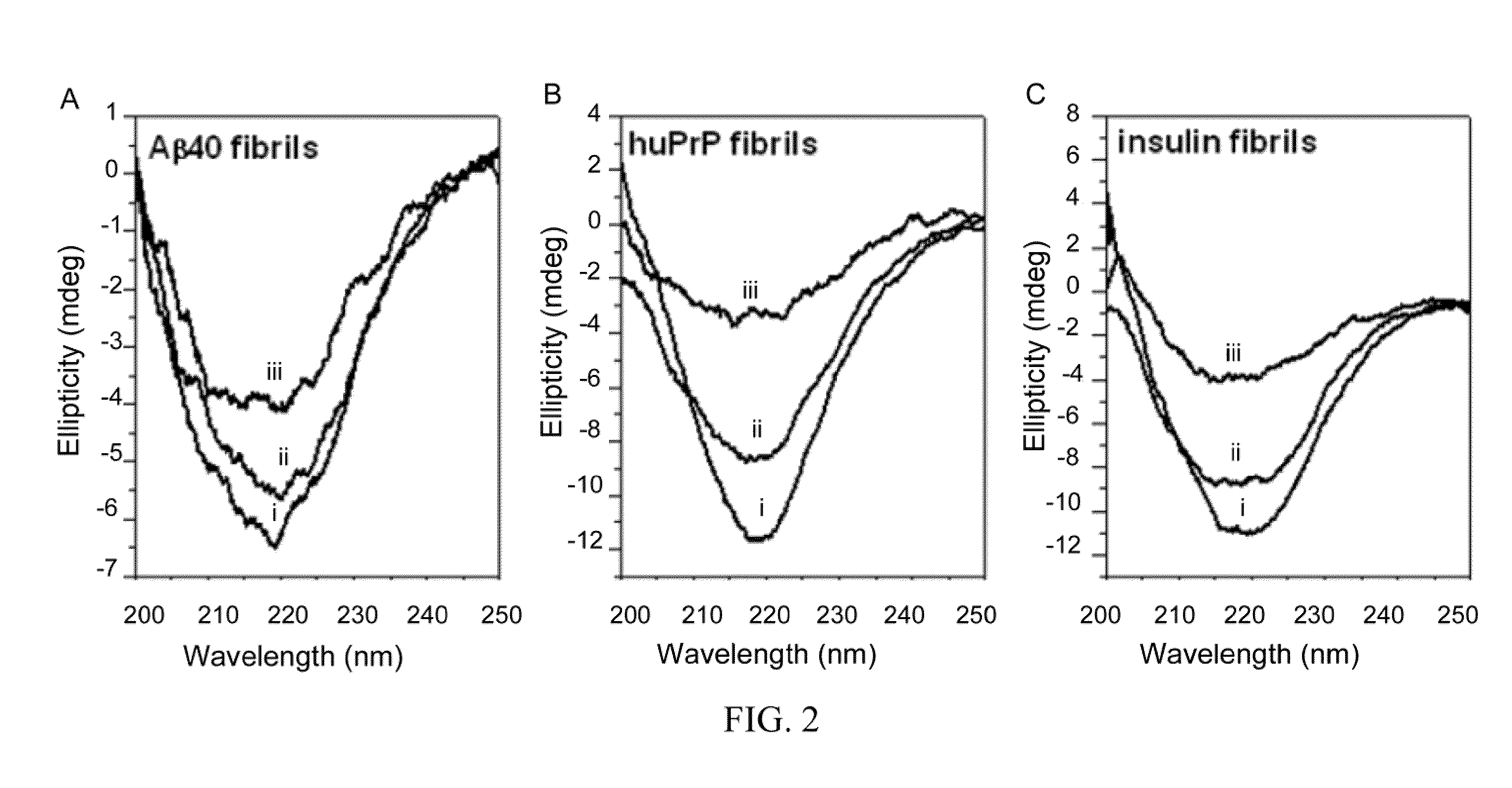Nattokinase for degrading and reducing amyloid fibrils—associated with alzheimer's disease, prion diseases and other amyloidoses
a technology of amyloid fibrils and nattokinase, which is applied in the direction of transferases, peptide/protein ingredients, metabolic disorders, etc., can solve the problems of inability to degrade amyloid fibrils, unstable intestinal tract, and high cost of other clinically thrombolytic agents, such as urokinase and streptokinase, and no interest in degrading amyloid fibrils
- Summary
- Abstract
- Description
- Claims
- Application Information
AI Technical Summary
Benefits of technology
Problems solved by technology
Method used
Image
Examples
example 1
Nattokinase Degrades and Reduces Amyloid Fibrils Formed from Peptides
[0069]Nattokinase was purified from a liquid culture by gel filtration chromatography. Fractions containing nattokinase were identified using the activity assay, then tested for the presence of a 27.7 kDa band on SDS-PAGE. The band was characterized by a N-terminal sequence analysis. Those fractions showing a pure protein were pooled and lyophilized (FIG. 1). FIG. 1 shows a 15% SDS-PAGE of a purified nattokinase, as indicated by the arrow.
[0070]To determine whether nattokinase has amyloid-degrading activity, Aβ40 fibrils formed from a synthetic Aβ40 peptide, huPrP fibrils formed from a synthetic human prion peptide (containing human prion protein amino acids 108-144 with valine at residue 129), and insulin fibrils formed from purified bovine insulin were used. At 40° C. and pH 7, nattokinase degraded all three fibrils, as shown by the decrease in the amplitude of the negative ellipticity at 218 nm in the CD spectra...
example 2
Nattokinase Digests Amyloid in a pH and Temperature-Dependent Manner
[0074]The fibrinolytic activity of nattokinase is known to be stable at neutral and alkaline pH (7-12), but labile below pH 5. To examine the effect of pH on the amyloid-degrading activity of nattokinase, we carried out proteolytic digestion of insulin fibrils over a broad range of pH values (pH 5-10) at 40° C. FIG. 4 shows degradation of insulin fibrils by nattokinase at different pHs. The digestion was carried out at 40° C. and monitored by CD spectroscopy. FIG. 4A shows the time-course of degradation monitored by measuring the remaining amyloid fibrils, and FIG. 4B shows percentage of amyloid degradation at different pHs calculated using the data for one hour of digestion. The 100% was defined as the CD ellipticity at 218 nm of the sample before treatment. The values are the mean±SEM for the results of two experiments. The results indicated that the nattokinase activity increased gradually with increasing pH and ...
example 3
Nattokinase is More Effective than Plasmin in Digesting Amyloid
[0077]Nattokinase and several other serine proteases were tested for their ability to digest Aβ fibrils at 37° C., pH 7. The proteases used were proteinase K (a keratinolytic enzyme and subtilisin-like serine protease used in research on prion diseases), subtilisin Carlsberg (a subtilisin-like serine protease), trypsin, and plasmin (a fibrinolytic serine protease). FIG. 6 shows the results of the comparison of Aβ40 fibril degradation by proteinase K, nattokinase, subtilisin Carlsberg, trypsin, and plasmin. The digestion was carried out at 37° C., pH 7 and monitored by ThT binding assay every 15 min. The 100% was defined as the fluorescence intensity at 487 nm of the control before incubation.
[0078]As shown in FIG. 6, at 37° C., pH 7 proteinase K and subtilisin Carlsberg degraded Aβ fibrils at the highest rates. The hydrolysis rate was slower for nattokinase and much slower for trypsin, while plasmin was ineffective. Alth...
PUM
| Property | Measurement | Unit |
|---|---|---|
| molecular mass | aaaaa | aaaaa |
| diameter | aaaaa | aaaaa |
| temperature | aaaaa | aaaaa |
Abstract
Description
Claims
Application Information
 Login to View More
Login to View More - R&D
- Intellectual Property
- Life Sciences
- Materials
- Tech Scout
- Unparalleled Data Quality
- Higher Quality Content
- 60% Fewer Hallucinations
Browse by: Latest US Patents, China's latest patents, Technical Efficacy Thesaurus, Application Domain, Technology Topic, Popular Technical Reports.
© 2025 PatSnap. All rights reserved.Legal|Privacy policy|Modern Slavery Act Transparency Statement|Sitemap|About US| Contact US: help@patsnap.com



